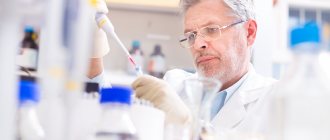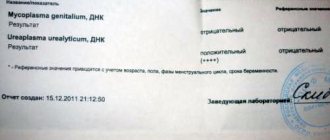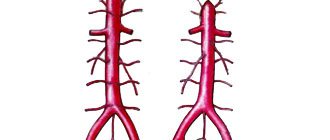What is a urological smear?
A smear can be defined as a diagnostic examination of a scraping from an organ.
It is widely used in both urology and gynecology. A urethral smear is a bacteriological microscopic examination of the microflora in the urinary canals, one of the most important components of a urological examination.
This analysis is part of a clinical study and often makes it possible to determine the cause of the patient's complaints after the first visit. With its help, doctors at our clinic can assess the condition of the patient’s genitourinary system and the presence of an inflammatory process. If the patient has sexually transmitted infections, the pathogens will be detected in the smear.
For men, a urethral smear is taken by a urologist , and for women, either a urologist or a gynecologist (along with scrapings from the cervix and vagina).
A urological smear is taken from patients, and then the resulting biomaterial is examined in the laboratory under a microscope.
In order to get a reliable picture and determine the diagnosis correctly, it is very important to follow the rules:
- six to seven days before taking a smear, stop taking antibiotics and other strong medications (of course, after consulting with your doctor);
- the day before taking the test, women should not do douching and do not insert vaginal tablets or suppositories;
- one day before the smear you should not drink alcohol;
- 24 hours (approximately) before the test you must abstain from sexual intercourse;
- an hour or two before the test you need to refrain from urinating;
- toileting of the genitals should be done the night before going to the doctor, and not in the morning.
Preparation
Proper preparation for sperm culture includes:
- intimate rest for 2-3 days before the study;
- exclusion from the diet of hot, salty and spicy foods, alcohol and medications the day before the examination;
- toilet your hands and penis with soap and water (do not use antibacterial soap) immediately before donating sperm.
- Antibacterial agents should be discontinued no later than 2-3 weeks before sperm donation. When collecting ejaculate, do not touch the walls of the sterile container.
What can be learned from the results of a urethral smear test?
When examining the material obtained from the urethra, the following is determined:
- leukocyte count;
- presence of red blood cells;
- the presence of mucus, purulent cells, flat epithelium in the urethra;
- the presence of typical bacteria, gonococci, chlamydia and other microorganisms;
- qualitative and quantitative composition of the flora.
Urogenital examination also helps to identify the causative agents of purulent inflammation - staphylococci, pneumococci, streptococci, Haemophilus influenzae bacteria and other enterobacteria. Various fungi are also identified (for example, candida, etc.).
When is a urological smear taken?
There are many indications for prescribing a urological smear test. This includes inflammation and infectious diseases of the genitourinary tract.
Be sure to prescribe a smear examination in case of atypical or purulent discharge from the urethra, as well as in case of unpleasant odor, itching or discomfort in the urethra.
For women, the indication for smear analysis is pregnancy, as well as vaginosis.
The analysis is sometimes prescribed for preventive purposes. A urethral smear is often an addition to culture studies for anaerobic infections.
How is a urethral swab taken from men?
This is a virtually painless procedure if the person is healthy. Painful sensations indicate that the walls of the urethra are damaged. Typically, such damage indicates inflammatory processes, as well as infectious diseases. And the degree of damage to the tissues of the urethra is expressed in the severity of pain after taking a smear from the urethra. In the glans penis, burning sensations and pain may persist for several hours after the procedure.
The doctor inserts a sterile dactron or cotton swab with a narrow applicator into the urethra to a depth of two to four centimeters. Then the applicator is slowly removed, gently rotating. The doctor applies the resulting material to glass for microscopic examination. For the study, epithelial cells obtained from both the tampon applicator and the tip are taken. Sometimes specialists collect material with a Volkmann spoon or use a bacteriological loop.
See also: Appointment with a urologist, Urological programs.
Technique for taking material for research
Technique for taking material for research
One of the most important stages in diagnosing chlamydia is the collection and delivery of biological material for research. It is this stage that is carried out in medical institutions of various profiles, while further processing of the material is carried out in specialized laboratories. Material for research For cytological and immunocytological research methods - scraping from the urethra or cervical canal, scraping from the conjunctiva of the eyes. In newborns, scrapings from the conjunctiva of the eyes are used as material for research. In girls, scrapings from the vulva are used as research material. For PCR - scraping from the urethra or cervical canal, prostate secretion, urine sediment, scraping from the conjunctiva of the eyes. In newborns, scrapings from the conjunctiva and posterior wall of the pharynx are used as material for research. In girls, scrapings from the vulva are used as research material; in boys, urine is used. For PCR - scraping from the urethra or cervical canal, prostate secretion, urine sediment, scraping from the conjunctiva of the eyes. In newborns, scrapings from the conjunctiva and posterior wall of the pharynx are used as material for research. In girls, scrapings from the vulva are used as research material; in boys, urine is used. Patient preparation, collection of biological material and conditions for its transportation When conducting cytological, immunocytological and ELISA (determination of bacterial antigen) studies, it is necessary to stop taking chemotherapy drugs and treatment procedures 10 days before taking the material for research. PCR or microbiological testing is recommended to be carried out no earlier than 1 month after the last use of antibacterial drugs. Due to the fact that Clamydia trachomatis is an intracellular parasite and multiplies only inside the cells of the cylindrical epithelium of the urethra or cervical canal, to obtain an adequate result, it is necessary that the largest possible number of epithelial cells and a minimum amount of mucus and blood admixtures be present in the test material. The presence of a large amount of mucus and blood in the test material can lead to both false-positive and false-negative results. Features of taking material from the urethra • before taking material, the patient is advised to refrain from urinating for 1.5-2 hours; • immediately before taking the material, the external opening of the urethra must be treated with a swab moistened with sterile saline; • immediately before taking the material, the external opening of the urethra must be treated with a swab moistened with sterile saline; • in women, before inserting a probe into the urethra, it is massaged on the pubic joint; • in women, the probe is inserted into the urethra to a depth of 1.0-1.5 cm, in men - to 3-4 cm, and then several rotational movements are made; in children, material for research is taken only from the external opening of the urethra; Features of taking material from the cervical canal • before taking material, it is necessary to remove mucus with a cotton swab and then treat the cervix with sterile saline; • the probe is inserted into the cervical canal to a depth of 0.5-1.5 cm; • if there are erosions of the cervical canal, they must be treated with sterile saline; the material should be taken at the border of healthy and changed tissue; • when removing the probe, it is necessary to completely avoid its contact with the walls of the vagina; Features of taking prostate secretions - Before taking prostate secretions, the head of the penis is treated with a sterile cotton swab moistened with saline solution. Prostate secretion is taken after preliminary massage of the prostate through the rectum. The therapist performs a pressure massage using several vigorous movements from the base to the apex. Then the prostatic secretion is squeezed out from the cavernous part, which is collected in a sterile container (wide-necked vessels, test tubes). Features of taking (collecting) urine Urine is collected in the morning on an empty stomach after sleep or no earlier than 2-3 hours after the last urination. When collecting urine, it is advisable to use a wide vessel with a lid; if possible, collect the urine directly into the container in which it will be delivered to the laboratory. The minimum volume of urine required for analysis is 20 ml. If not all collected urine is delivered to the laboratory, it must be thoroughly shaken before some of the urine is poured into a container for transportation. Features of taking material from the back wall of the pharynx A disposable probe is inserted behind the soft palate into the nasopharynx and passed along the back wall of the pharynx. After taking the material, the probe is lowered into a test tube with a special transport medium. After introducing the probe into the transport medium, it is rotated several times and then removed from the tube. The tube is closed and labeled. Features of taking material from the conjunctiva of the eyes If there is abundant purulent discharge, it is removed with a sterile cotton swab moistened with saline solution. A scraping is taken from the inner surface of the lower eyelid moving towards the inner corner of the palpebral fissure. When taking a scraping, you must hold the eyelid with your hands so that when you blink, the eyelashes do not touch the probe. For cytological and immunocytological studies, scraping material is distributed on a glass slide, dried in air or fixed in ethyl (wine) alcohol 960 or acetone. The glasses are stored at a temperature of +40C-+80C until sent to the laboratory. After taking scraping material for PCR research, the probe is lowered into a test tube with a special transport medium. After introducing the probe into the transport medium, it is rotated several times and then removed from the tube. The tube is closed and labeled. If the transportation time of biological material from the moment of its collection to the moment of delivery to the laboratory is more than 2 hours, then the tube must be frozen at –200C. Transportation of scraping material should only be carried out in a cooler bag. When frozen, scraping material can be stored for no more than 2 weeks. Prostate secretion should be delivered to the laboratory within 1-3 hours. It should be transported only in a cooler bag. Urine is delivered to the laboratory within 1-3 hours without additional cooling. Long-term storage of urine at room temperature before testing leads to a change not only in its physical properties and cell destruction, but also to the proliferation of bacteria. After taking scraping material for ELISA testing, the probe is lowered into a test tube with a special transport medium, which is stored at +40C - +80C until sent to the laboratory. If the transportation time of the scraping material from the moment it is taken to the moment it is delivered to the laboratory is more than 2 hours, then the tube must be frozen at –200C. Collection, storage conditions and delivery of material for ELISA testing (determination of antibodies to Chlamydia trachomatis). Material for research Blood serum that does not contain admixtures of erythrocytes, bacterial contamination, chylosis and hemolysis is subject to research. If any of these signs are present, the serum is destroyed and a repeat blood draw is prescribed. Blood is drawn in the morning on an empty stomach. If blood collection is carried out in the immediate vicinity of the ELISA laboratory, then immediately after collection, the test tube with blood is immediately delivered to the laboratory for testing. If transportation is necessary, serum is obtained from the blood. To do this, the blood is centrifuged. After centrifugation, the serum is separated from the clot and blood cells and placed in a refrigerator at +40C - +80C or frozen at –200C. Blood serum is sent to the ELISA laboratory in an amount of at least 1.5 ml in a closed unbreakable tube in a special container (thermos with ice or cooler bag). When testing serum for several indicators, it must be collected in a sterile tube with at least 0.5 ml for each marker or type of antibody. Collection, delivery and storage of biological material for microbiological research. The material being examined is scraping from the urethra, prostate secretion (in men), scrapings from the urethra, cervix (in women), scrapings from the conjunctiva of the eye. 1 month before microbiological testing for Chlamydia trachomatis, patients should avoid taking antibacterial drugs. To take biological material, probes are used that are attached to a test tube with a transport medium. In women, it is best to take biological material no earlier than 14 days after menstruation. Before taking the material, patients are advised to refrain from urinating for 1.5-2 hours. In the presence of purulent discharge, it is recommended to take a scraping 15-20 minutes after urination. If there is no discharge, it is necessary to massage the urethra using a probe to take material. When examining women, material is taken from the urethra using a disposable sterile probe. The urethra is massaged with a finger from the side of the vagina, pressing it from the side of the pubic bone. The probe is inserted to a depth of 1.5-2 cm and biological material is obtained by lightly scraping the anterior and lateral walls of the urethra. Immediately after collection, the probe is lowered into a test tube with a special transport medium. Material is taken from the cervical canal of the cervix only after the cervix is opened using speculum. After the cervix is opened in the speculum, the vaginal part is wiped with a dry cotton swab. The material must be sampled with a probe. The probe is inserted into the cervical canal 1-1.5 cm, carefully turning, and removed without touching the walls of the vagina. After taking the biological material, the probe is placed in the transport medium. In men, the test is carried out in the morning before urination, or patients are advised not to urinate for 4-5 hours before taking the sample. To obtain material when scraping from the urethral mucosa, the distal part of the penis is taken between the third and fourth fingers of the left hand, and the lips of the external urethral opening are pulled apart with the index and thumb of the same hand. A sterile disposable probe is inserted into the urethra to a depth of 3-4 cm and scraping is performed from the urethral mucosa. With very scanty discharge, patients can undergo a light massage of the urethra, and then take the material. In case of heavy purulent discharge, it is recommended to take material after urination. A scraping from the surface of the urethra is taken without blood, since the presence of blood in the smear affects the isolation of a pure culture of Chlamydia trachomatis. The resulting material is transferred to special transport media. The secretion of the prostate gland is taken after appropriate treatment of the glans penis through massage through the rectum. The doctor performs a pressure massage with several vigorous movements from the base to the apex. Then the prostatic secretion is squeezed out from the cavernous part, which is collected in a sterile tube. After taking the material, the tubes with the transport medium can be stored in the refrigerator (do not freeze) at a temperature of +40C - +80C for 48 hours.







